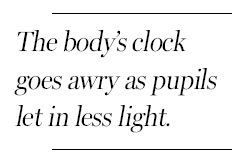

For decades, scientists have looked for explanations as to why memory loss, slower reaction time, insomnia and even depression occur with age. They have investigated such suspects as high cholesterol, obesity and an inactive lifestyle.
Now research supports a largely unrecognized culprit: the eye.
As the eyes age, less and less sunlight gets through the pupil and lens to reach cells in the retina that regulate the body's circadian rhythm.
"We believe the effect is huge and that it's just beginning to be recognized as a problem," said Dr. Patricia Turner, an ophthalmologist in Leawood, Kansas, who with her husband, Dr. Martin Mainster, a professor of ophthalmology at the University of Kansas Medical School, has written extensively about the effects of the aging eye on health.
 |
Circadian rhythms are the physiological processes that rally the body in the morning to tackle the day's demands and slow it down at night. This internal clock relies on light. Studies have found that people whose circadian rhythms are out of sync, like shift workers, are at greater risk for ailments like insomnia, heart disease and cancer.
"Evolution has built this beautiful timekeeping mechanism, but the clock is not absolutely perfect and needs to be nudged every day," said Dr. David Berson from Brown University in Providence, Rhode Island.
So-called photoreceptive cells in the retina absorb sunlight and transmit messages to a part of the brain called the suprachiasmatic nucleus (SCN), which governs the internal clock. The SCN adjusts the body by initiating the release of the hormone melatonin in the evening and cortisol in the morning. Melatonin is thought to have many health-promoting functions.
Dr. Berson's team discovered in 2002 that cells in the inner retina had photoreceptors that communicated more directly with the brain and were especially responsive to the blue part of the light spectrum.
In a study published in The British Journal of Ophthalmology, Dr. Mainster and Dr. Turner estimated that by age 45, the photoreceptors of the average adult receive just 50 percent of the light needed to fully stimulate the circadian system. By age 55, it dips to 37 percent, and by age 75, to a mere 17 percent.
 |
"Anything that affects the intensity of light or the wavelength can have important consequences for the synchronization of the circadian rhythm, and that can have effects on all types of physiological processes," Dr. Berson said.
One study, published in the journal Experimental Gerontology, compared how quickly exposure to bright light suppresses melatonin in women in their 20s versus in women in their 50s. The amount of blue light that significantly suppressed melatonin in the younger women had absolutely no effect on melatonin in the older women.
Researchers in Sweden studied patients who had cataract surgery to implant clear intraocular lenses. They found that the incidence of insomnia and daytime sleepiness was significantly reduced.
Dr. Mainster and Dr. Turner believe that with age, people should make an effort to expose themselves to bright sunlight or bright indoor lighting when they cannot get outdoors. Older adults are at particular risk, because they spend more time indoors.
"In modern society, most of the time we live in a controlled environment under artificial lights, which are 1,000 to 10,000 times dimmer than sunlight and the wrong part of the spectrum," Dr. Turner said.
In their own offices, Dr. Mainster and Dr. Turner have installed skylights and extra fluorescent lights to help offset the aging of their own eyes.
The New York Times